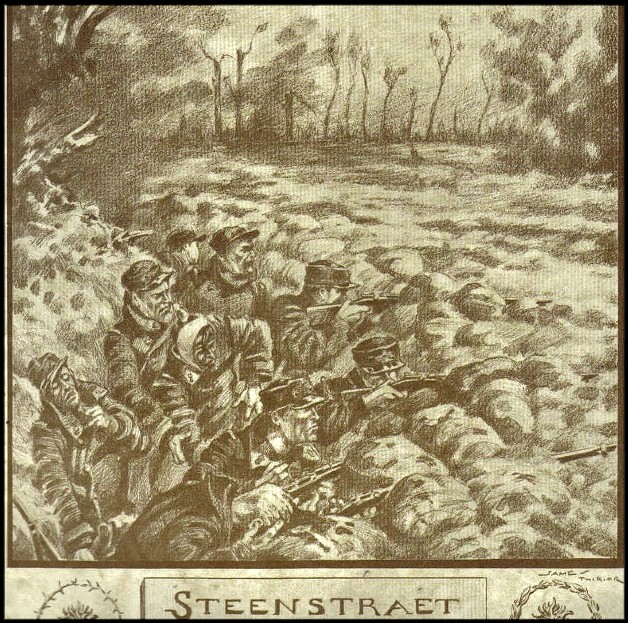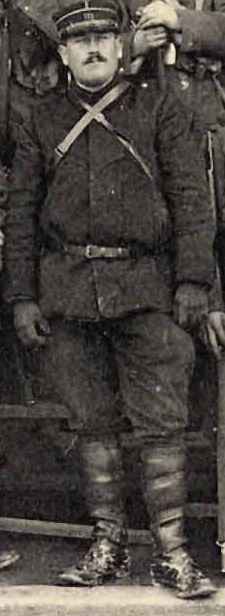Campaign History of the 151e Régiment d'Infanterie - III
~ 1914 ~
Battles of the Yser and Ypres (19 October - 10 November)
19-22 October: In the early morning, 1 Bat. boards a train (20 cars, 60 horses) at Oiry, followed by 3 Bat. (21 cars, 89 horses), and then 2 Bat. (20 cars, 74 horses). 1 Bat. arrives at Dunkirk at 1500 hrs the next day, billeting at Coxyde (Koksijde) just across the Belgium border. 3 Bat. disembarks at Adinkerke and billets at La Panne in tramways.
At Dunkirk, Capt. Lehoux brings a reinforcement detachment to billet at La Panne. It is comprised of 2 officers, 1 auxiliary-doctor, 2 nurses, 16 NCOs, and 484 corporals and men.
On the morning of 21 October, 2 Bat. disembarks at Adinkirk (Adinkerque) and billets at La Panne where it arrives at 0800 hrs. At 0600 hrs, the reinforcement detachment is assembled and repartitioned in the regiment by 0900 hrs. At 1100 hrs, General Grosetti passes in review the 3 Bat. No other dispositions made save that two companies of the 3 Bat. are lodged in La Panne church. The next morning, at 0600 hrs, 1 Bat. is sent to the west of Dunkirk where it assembles with the other units of 84 BI, facing Nieuport (Nieuwpoort). At the same hour, the 151 leaves La Panne heading toward Kokseffectmovement of 1 Bat. The 2 Bat. forms to the north of Koksijde, 162 RI to its right. During the day, the battalion leaders reconnoiter the Yser River passages at Nieuport and makes contact with the Belgian troops in the first line. No further movement is made. In the evening, 1 Bat. and the general-staff billets at Zeepanne, 2 Bat. at Saint-Idesbalde, 3 Bat. at Kerkepanne (Kirkpanne).
23 October: At 0600 hrs, the 151 forms the body of the column (in the order of 3, 2, 1 Bats.). Reaching Nieuport at 1000 hrs, it passes over the Yser using six bridges, preceded by the 162 RI. German artillery shells the bridges during the crossing, slowing the movement considerably. Belgian troops, along with their numerous automobile convoys, jam the roadways and further slow the progress of the division.
Colonel Delville (commanding 84 BI) first orders the 151 to attack the Groote Bamburgh farm, with one battalion in front and two others in support. This is countermanded by General Grossetti (commanding 42 DI), who instructs the regiment cross the bridges and then to move along the embankments of the right bank, taking the lock 1500 meters southeast of the lighthouse, facing the Crombez Pavilion. The regiment will then attack the pavilion with its three battalions in depth. The ulterior objective of this attack is to take Westende.
Rain is pouring down as regiment begins its movement at 1030 hrs, crossing the Yser and the canal in small groups over narrow pontoon footbridges under artillery fire. By 1130 hrs, 3 Bat. completes its crossing of the Yser. During the crossing the Commandant Monphous' horse is killed. Progress is slowed by the sands as the battalion approaches Lombaertyde [Lombardsijde]. At 1230 hrs, two companies of the 3 Bat. are assembled at the step-off point for the attack. Due to a rupture in one of the footbridges over the river (700 meters to the west of the bridges), the movement is considerably delayed. The 12 Co. and the 2 Bat. only arrive at the point indicated at 1540 hrs. The liaison between the PC of 84 BI and the 151 proves very difficult to maintain, with orders taking an hour to arrive. The 2 Bat. and 3 Bat. of the 151 are first put in general reserve of the 84 BI before being released back to Colonel Delville's control.
At 1600 hrs, 3 Bat. launches its attack on Crombez Pavilion, then Westende with two companies in line (9 and 10 Cos.) and two immediately following these. The attack is supported on the left by one battalion of the 162 RI, which moves to the right of Lombartzyde (Lombardsijde) (another battalion of the 162 crosses the Yser on a ferry boat to Nieuport-Bains and must progress over the dunes). At 1620 hrs, 2 Bat. follows the movement of the 3 Bat., in echelon to the right rear, heading in the direction of the center of Lombartzyde and the Crombez Pavilion towards Stads farm. At 1730 hrs, German artillery opens up on the advancing French units.
3 Bat. continues its march and is able to pass over the Belgian trenches, advancing to 500 meters south of the village of Westende. However, the battalion of the 162 RI in support on the left is unable to make similar progress and stops on the Lombartzyde - Maison scolaire road, at the top of the Stads farm. At 1745 hrs, 2 Bat. is at the top of the Belgian trenches and passes one company to the right of the 3 Bat. in order to make a junction between 3 Bat. and Deville's battalion of the 162 RI, which straddles the Lombartzyde - Westende road. 1 Bat., which has followed the movement of 2 Bat., shifts to the right and goes to billet at Lombartzyde.
At 1815 hrs, the PC of the 151 RI is set up at the northwest entrance of the village and an half hour later, the order to halt the advance comes. All night long, the village is bombarded by the German guns. Thanks to the 8 Co., the liaison is established between the 3 Bat/151 RI and Téral's battalion of the 162 RI. Deville's battalion of the 162 RI on the left (in the dunes) comes up behind the left flank of the 3 Bat/151 RI. The other battalion of the 162 RI (Haldast) is behind Deville's.
Killed: 5 Co. - Sous-Lieut. Moulin. 2 Co. - Sgt. Richardeau. 5 Co.
Wounded: 6 Co. - Cpl. Guillin, Tambour (drummer) Descamps, Sdts. Hopin, Riché. 7 Co. - Caps. André, Formentin, Heremeyer (sp?), Brancardier (stretcher-bearer) Fritch, Sdts. Liegeois, Bandart. 5 Co. - Capt. Hameline, Sgt. Lesaffre, Cap. Glorian, Gérard, Thibault, Sdts. Brantin, Boune, Sou, Servour (sp?), Hérant, Wiou, Saudron, Bramillard, Duberquoy, Chrétien, Pandroy, Berlemont, Ducrocq, Buguicourt, Patte, Mitrailleur (machine-gunner) Hanssaire.
Missing: 5 Co. - Frémeau, Grange, Deveneil (sp?), Graffte. 7 Co. - Bonhomme, Dervais.
Map showing engagements on 23 October. The 151 RI (84 BI) area of action is highlighted in red.

The night is pitch black as a relentless rain transforms the ground into a swamp. Then, at 0230 hrs a general fusillade erupts along the whole front of 3 Bat. as the Germans launch a counter-attack on the battalion's left. Again and again, the Germans attack, fall back, and attack again. On two separate occasions, 10 Co. is encircled but manages to fight off the attackers. The firing, which lasts until dawn, is so prolonged and intense that the two left companies of the 3 Bat., occupying trenches, run out of ammunition.
24 October: The night is dark under a relentless rain that transforms the ground into a swamp. Then, at 0230 hrs a general fusillade erupts along the whole front of 3 Bat. as the Germans launch a counter-attack on the battalion's left. Again and again, the Germans attack, fall back, and attack again. On two separate occasions, 10 Co. is encircled but manages to fight off the attackers. The firing, which lasts until dawn, is so prolonged and intense that the two left companies of the 3 Bat., occupying trenches, run out of ammunition. At 0600 hrs, Capitaine Dutour, feeling his left is in danger of being overwhelmed and knowing the 162 RI to be too far away to effectively strengthen him, shifts 8 Co. aside to disengaged it.
Commandant Monphous is informed of these developments and requests the battalions of the 162 RI positioned in the dunes to move forward so as to protect the flank-guard of the 151. By 0700 hrs, with the battalions of the 162 still not appearing in support, the left most company of the 2 Bat. (in the second line) is detached in echelon to the left of the first line while a second request is sent to the 162 RI for support. Yet before the detached company of the 2 Bat. is able to get into position, 8 Co. is assaulted by a strong enemy detachment (about two companies) at only 25 paces away. 8 Co., which had not had the time to entrench, immediately came under the enemy's fire and rushed to reach the refuge of the neighboring company's trench. At 0730 hrs, the enemy arrives on the fleeing company's heels encircles a half-section and opens up a withering enfilade fire on the entire battalion. Enduring this fire for an hour, 3 Bat. is forced to withdraw and after reordering itself, occupies a first line located about 250-300 meters in front of the Lombartzyde - Maison scolaire road. Thus, by late morning the 151 finds itself in a bad spot, with the left side of its line drive back, the entire line then being under enfilading fire from the dunes, and an entire half-section taken prisoner.
By noon, the situation for 84 BI is as follows: instead of continuing the offensive on Westende, the entire brigade in a defensive position and organizing its positions. It is divided into two sub-sectors with the 151 in the left sub-sector under the orders of Lieut-Col. Clandon (162 RI) and includes the 162 RI, and the 2 Bat. and 3 Bat. of the 151.
In 1st line: five companies of the 151 RI (3 Bat. and 8 Co.); to the right (north of Lombartzyde) is Téral's battalion of 162 RI, in liaison with the 16 BCP near Groote Bamburgh farm; to the left are five companies of the 162 RI.
In 2nd line: three companies of the 2 Bat/151 RI, their right at the top of the village on the Maison scolaire road.
1 Bat. and two companies assigned to it of the right sub-sector are holding the bridge head of Nieuport, and two companies of the left sub-sector to the south of Lombartzyde.
The situation for the brigade remains unchanged for the rest of the day.
2 Co. - 1 WIA
3 Co. - 1 WIA
4 Co. - 1 WIA (Sgt-Mjr. Cudelon)
6 Co. - 1 KIA
7 Co. - 12 WIA
8 Co. - 1 KIA, 28 WIA, 34 MIA (incl. Sgt-Mjr. Ghérardi)
9 Co. - 36 MIA (incl. Sgt-Mjr. Jourdan)
10 Co. - 3 KIA, 13 WIA
11 Co. - 2 KIA, 21 WIA, 33 MIA
25 October: At 0400 hrs, 2 Bat. (including 8 Co., which has left the first line during the night) departs Lombartzyde to occupy the Furnes (Veurne) Road, le Syphon and the Pelican Bridge (Pelikaanbrug). While en route, it receives counter-orders and is directed to the Bois Triangulaire to the west of Nieuport. At 0700 hrs, 1 Bat. is ordered to also depart Lombaertzyde and rally its two companies at the bridge head, reassembling on with 2 Bat. in the Bois Triangulaire. (These two battalions are under Commandant Monphous' orders). 3 Bat. remains in the first line with the 162 RI for the defense of Lombartzyde to the north of the Yser.
2 Bat. leaves a half company guarding Syphon and another half company guarding Pelican bridge. At 1015 hrs, 1 Bat. is instructed to extend itself to join up with a battalion of Belgian chasseurs, which is to the east of Nieuport, along the Ramscappelle Road. At 1230 hrs, is ordered to halt with two companies on the Ramscappelle Road and two companies along the rail road. At night, 3 Bat. is to be relieved in the first line in front of Lombaertzyde by a battalion of the 162 RI. But at 2100 hrs the Germans launch a strong infantry and artillery attack, which rages on throughout the night. 3 Bat. will be forced to fall back and is pressed up against the right (i.e. north) bank of the Yser where the men dig rudimentary entrenchments. As high-tide comes in the water level of the Yser rises and floods the shallow trenches. Despite the hardships, the men manage to hold onto their positions. Thanks in part to the actions of the 151, Belgian engineers are given the time they needed to make plans for the flooding of the plain.
26-28 October: At 0500 hrs, 1 Bat. marches to Ferme d'Allaertshoch (Allaertshuizen / Allaertscoek). At 0600 hrs, 2 Bat. leaves Oost-Dunkerke and, via Welpen (Wulpen), takes up positions along the canal and the Furnes Road. At 0700 hrs, 3 Bat. leaves its positions near Lombartzyde and put under the disposition of the 162 RI in order to cooperate in the defense of Nieuport. Meanwhile, the 1 Bat. and 2 Bat. are told to push up to the Belgian positions along the Nieuport-Dixmude (Diksmuide) railway, and then to Groostdijh canal. By 1500, 1 Bat. has entrenched itself along the canal 700 meters east of Boitshouke (Booitshoeke), facing east. The 2 Bat. moves up to Chapelle in echelon to the right of 1 Bat. At 1600 hrs, orders arrive from brigade instructing the regiment to have one battalion install itself at Chapelle and another at Ferme de Violon.
At nightfall, 1 Bat. is at the rail road and mixed together with Belgian units, with its right at the train stop (~ 2km southwest of Ramscappelle on the Nieuport-Dixmude Road) and its left at T. de Lichterfelde (Lichtervelde). 2 Bat. has its right on the same point and its left in liaison with the Belgian forces southeast of Ramscapelle (Ramskapelle). Back in Nieuport, 3 Bat. has one company stationed at the locks and three companies at the Bois Triangulaire.
Killed: Coleau.
Wounded: Sgt-Mjr. Mérandm Sgt. Demutière, Sdts. Schlermits, Delay, Pincon, Desert, Hardy, Chrétien, Bautéguie, Bellet, Picq.
Missing: Sdts. Catterelle, Leroy, Lemarie, Degrave, Bourgin, Ineicher.
Photos taken on 28 Oct. 1914 on the outskirts of Dixmude showing an unidentified unit of the 42 DI sheltering along the Nieuport -- Dixmude railway embankment as Dixmude burns in the background caused by German artillery fire. Note the drum in the middleground of the photo on the left.


The next day, the Germans open up a heavy bombardment of the regiment's positions, as the 2 Bat. organizes strong entrenchments. At 0600 hrs, 3 Bat. arrives at Boitschouke and occupies the trenches dug by 1 Bat. along the Grootsdijch canal. The positions are organized into two sectors with the right sub-sector comprised of the 151 and Belgian troops under the Commandant Monphous' command (151). The day proves to be a calm one, and for good cause. In the morning, at high-tide, the Belgian engineers open the sluice gates in a desperate bid to halt the German advance. The old lock at Furnes (Veurne) quietly lets the seawater drain toward the enemy lines that are already so saturated by the rains. In the evening, 3 Bat. takes up billets in Boitschouke.
During the night, the engineers set to work constructing a second footbridge over the canal to the west of Groot Noordhof farm. The next day (28 October), a three-hour bombardment of the enemy's positions opens up at noon along the whole front. The inundation of the plain to the east of the railway has still not occurred.
2 officers killed: Sous-Lieut. Moulin, Sous-Lieut. Lépine.
1 officer wounded: Capt. Hameline.
37 [men] killed.
172 [men] wounded.
14 [men] missing.
[Total: 226]
29 October: 1 and 2 Bats. continue to occupy their trenches, while 3 Bat. remains at the Cinque Maisons in Boitschouke, with 16 BCP in the trenches to the east of the Boitschouke. Throughout the day a constant infiltration of German troops goes on along the regiment's front, which faces heavy French artillery fire. 1 Bat. telephones in that the Germans suffer terrible losses in consequence and that the enemy's attacks are stopped only very close to the French lines. At 1700 hrs, 3 Bat. sends two of its companies to Groot Noordhof farm. At 2230 hrs, the Germans renew their attacks.
Killed: Adj. Jacques, Sdts. Poulain, Patte, Pollard, Clabault, Pfléger, Bonchy.
Wounded: Lieut. Ritter, Sgt. Fossier, Caps. Tauton, Alexandre, Sdts. Ducrocq, Blondel, Delporte, Charles, Drancour, Damard, Gobert, Santer, Lengrand, Termisroen (sp?), Dubois, Hubert, Bertrand, Laporte, Marquillard, Douise, Vaxin, Leclet, Maguet, Evrard, Courdray, Chailey, Bourdeauduc.
Map showing engagements on 29 October. The 151 RI area of action is highlighted in red.

30 October:
At 0600 hrs, the enemy resumes its night attack on the regiment's left. The Belgians give way and the Germans take the railway, leaving 2 Bat/151 RI in a critical position. At 0700 hrs, Commandant Pascal (commanding 2 Bat.) is seriously wounded and Sous-Lieut. Marchand takes command of the battalion. Half an hour later, a withering enfilade fire from German machine-guns forces a company of 2 Bat. to face Ramscapelle, which threatens to push back the entire line. Throughout the day, until 1600 hrs, despite this menacing fire the 2 Bat. manages to maintain its position while inflicting losses on the enemy, along with the 1 Bat.
At 0800 hrs, the two companies of the 3 Bat. that are still at Cinque Maisons are transported to Klein-Noordhof. At 1600 hrs, 3 Bat. takes part in the general attack to retake Ramscapelle, supported to its right by 2 Bat. and to its left by two companies of zouaves [4 RM], a battalion of tirailleurs [8 BT], the 16 BCP, and Belgian troops. At 2100 hrs, 3 Bat. has passed the road to the north of Ferme de Violon, but is unable to get a foothold on the railway with the 10 Co. around 2230 hrs. In the attack, 400 German prisoners are also taken.
Killed: Adj. Codeline, Sgts. Collin, Bermer, Cpl. Manhavel, Sdts. Prêté, Bencome, Lesur, Mathier, Perrignon, Cherquefosse.
Wounded: Cmdt. Pascal, Capt. Tison, Sous-Lieut. Antoine, Sgts. Massot, Flamant, Fourrier-Sgt. (quarter-master) Dubois, Caps. Lucien, Mermier, Ducrocq, Sdts. Husson, Aubert, Lefévre, Godart, Duquesnoy, Soupplet, Grislin, Cléron, David, Guiffon, Giette. Pollet, Lefévre R., Laflotte, Bamquins (sp?), Talon, Fallemin, Magotteaux, Gente Zéphir, Leclerq, Cheval, Gun (sp?), Bouette.
Missing: Sdt. Duval.
Map showing engagements on 30 October. The 151 RI area of action is highlighted in red.
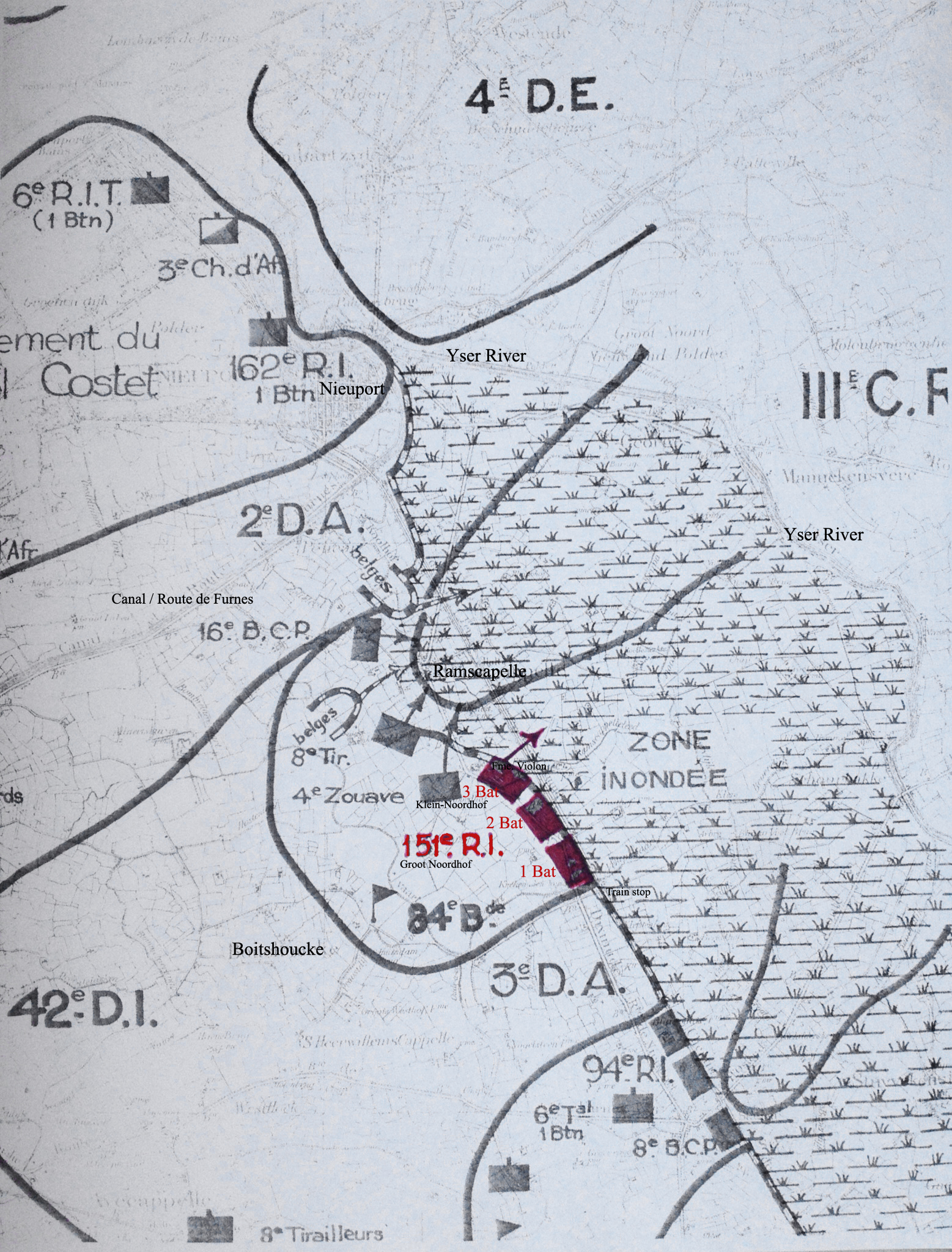
31 October: With the enemy evacuating the railway at dawn, 3 Bat. reoccupies it at 0700 hrs. At 0800 hrs, Commandant Monphous is gravely wounded by a shell fragment while going from Ferme de Klein-Noordhof to Ferme de Violon. Commandant Bontin takes command of the regiment, with Capt. Pernnet taking command of 1 Bat. and Capt. Lehoux, 2 Bat.
At 1500 hrs, a detachment of reinforcements arrive and in the evening, the effectives are divided up between the companies of the regiment. The detachment consists of:
5 officers: Capt. Clémendot, Capt. Rotté, Lieuts. Aubry and Vallé, Sous-Lieut. Bocquillon.
1 adjudant and 12 sergents.
206 caporaux and soldats.
At 1900 hrs, 1 Bat. after being relieved at the train stop by 2 Bat. which shifts to the right. goes to bivouac at Cinque Maisons in Boitshoucke. Capt. Clémendot takes command of 1 Bat.
1 November: No movement during the day. 2 and 3 Bats. are on the railway, with 1 Bat. occupying the trenches to the southwest of Cinque Maisons. At 1900 hrs, 2 Bat. goes to bivouac at Boitschouke after being relieved by 3 Bat., which slides to the right toward the train stop, with 3 Bat. itself being relieved by Belgian troops. At 2000 hrs, Capt. Hameline returns from the hospital at Dunkerque and retakes command of 2 Bat.
2 November: At 0530 hrs, 1 and 2 Bats. are directed to Oostkerke to participate in an assault on Dixmude (Diksmuide). The circuitous route the battalions travel -- via Boitschouke, Furnes Road, Avecapelle, and the railway -- causes them to be an hour late in arrival. At 1000 hrs, the regiment crosses the bridges over the Yser at Dixmude behind the 8 BCP, which attacks the château 1 km south of Dixmude.
At 1030 hrs, the regiment (in the order of 1 Bat., 2 Bat.) are ordered to move over the footbridge even with Essen (Esen) Road, face to the right and take as a first objective the farms to the southeast of Dixmude. By 1130 hrs, 1 Bat. is engaged and reaches the trenches of the fusiliers-marins and Senegalese, who are occupying Dixmude at the bridge head. By 1500 hrs, the movement of 1 Bat. has been followed by the 2 Bat. The 5 and 6 Cos. are engaged around 1530 hrs to block a gap that forms between the lines of the 1, 2, and 4 Cos., which are facing the farms to the southeast of Dixmude, and the 3 Co. which bars the Essen Road.
The regiment makes progress but is unable to move beyond the trenches previously occupied. At 1700 hrs, after a preparatory artillery barrage and using the cover of darkness, 6 Co. leaves its trenches and advances 250-300 meters. 7 and 8 Cos. are in reserve at the Dixmude train station. Holding orders are issue at 1900 hrs with no further movements. 3 Bat. is resting in reserve at the Boitschouke train stop in the trenches along the railway.
Killed: Sdt. Guilbert.
Wounded: Lieut. Birie-Abbas, Sous-Lieut. Duasse, Sgt-Fourrier Godeau, Sdts. Sarranin, Grauzelle, Riefflé, Brossardm Marandel, Chaumet, Lelarge, Marlette.
Missing: Cap. Hupin.
Map showing 151 attach on 2 November. Source: AFPGG.

3 November: The attack is resume during daylight against strong enemy positions. The companies entrenched in the first line during the night are about 350 meters from the German positions. All day long, they are pounded by a strong enfilading artillery bombardment. Though offering rifle and machine-gun fire to support the 8 BCP's attack on the château, the chasseurs are unable to make any progress. The entrenchments made during the night are not strong enough to shelter the 151 companies in the first line, which suffer significant losses as they sit powerless and unprotected under the deluge of German small arms and artillery fire. In the evening, 5 and 6 Cos. are relieved by 7 and 8 Cos., the former being placed in reserve at the train station.
4 November: The 42 DI is ordered to resume its attack on the enemy positions. The objective remains the château south of Dixmude, which is to be attacked from the north by the 8 BCP and from the west by the 83 BI, crossing footbridges over the Yser at the loop of Saint-Jacques-Capelle (Sint-Jacobskapelle). The 151 must cover the wall facing east.
From 0630 to 1200 hrs, the division's first line holds the Germans under their fire. By noon, the 8 BCP had still not arrived and is replaced by a battalion of tirailleurs who must support the regiment's attack. The two companies of the 2 Bat/151 RI that were to be engaged make only nominal progress.
By 1400 hrs, despite all the fire being poured onto the Germans, the tirailleurs are unable to reach the château and can only deploy one and half companies, which suffer severe losses. Only 4 Co/151 RI, which was behind the first line and in liaison with the 8 BCP, is able to make a bound forward of about a hundred meters, where it then entrenches itself. The rest of the line is unable to advance.
In order to facilitate the command, 3 Co. which is on the Essen Road and separated from its battalion is relieved by 5 Co., so that each of the two battalions has three companies in line and one in reserve. Capt. Segonne (transferred from 8 BCP) takes command of 1 Bat and Capt. Clémendot takes command of 2 Co. The 3 Bat. is billeted at Lamperuisse.
Killed: Cap. Ricard, Sdts. Alain, Polin, Gâteau.
Wounded: Cap. Maguart, Sdts. Bernard, Milan, Paquin, Huvart, Fortie, Lebland, Boyer, Condray, Dumotier, Bluetre, Lalange (sp?), Delbecq, Brouttin, Cuvillard, Lemon.
Left: map showing engagements on 4 November and approximate area of action for the 151 RI (42 DI). Right: Ypres, 5-9 November 1914.
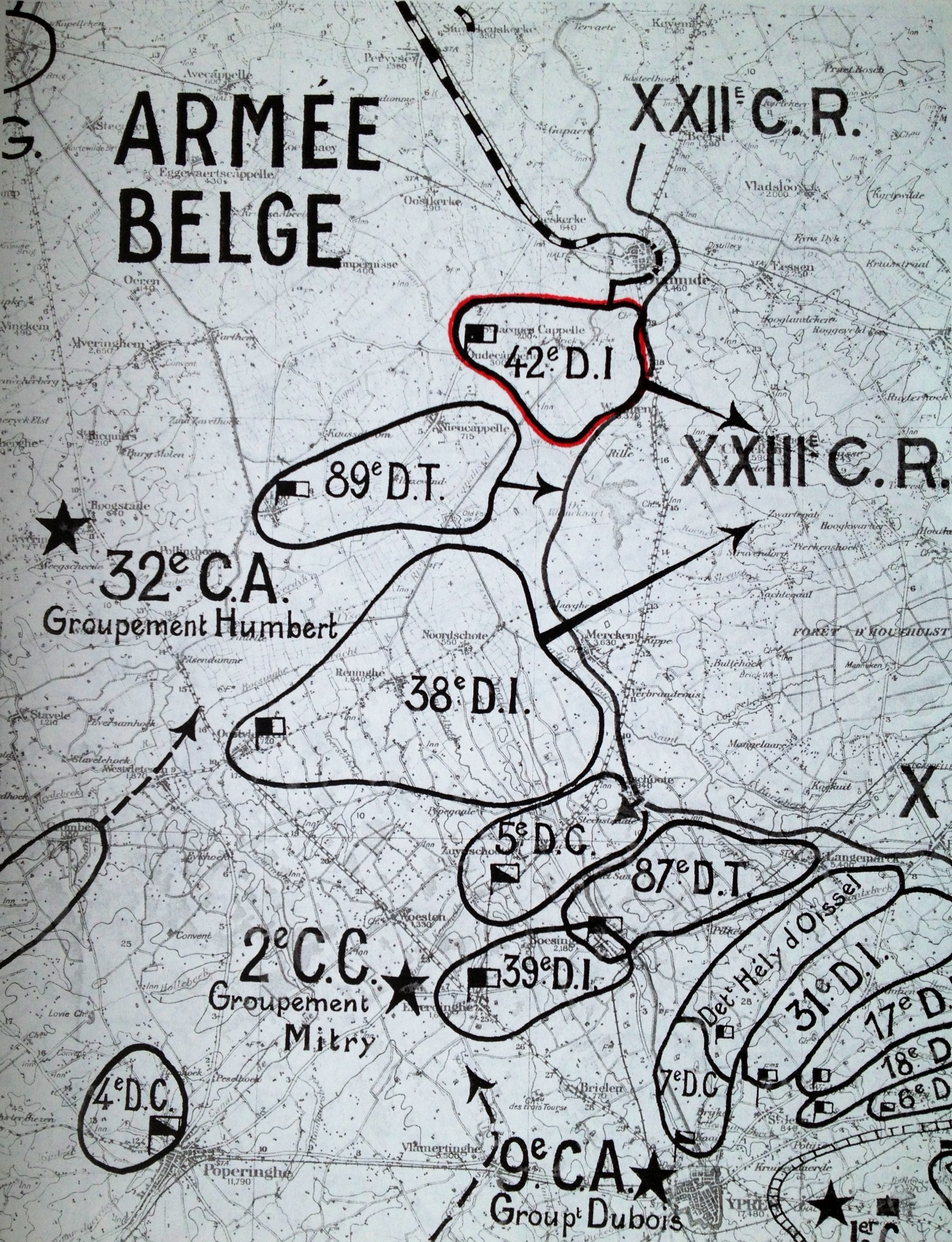

5 November: The attack on the château is resume by the 8 BCP, the 83 BI, and a battalion of tirailleurs. The 151 struggles to reach the farms southeast of Dixmude and on the road northwest of Bon secours and Essen. At 1100 hrs, despite an intense artillery preparation, the regiment in unable to leave its own trenches, so great is the German return fire. At 1330 hrs, a second artillery barrage is opened on the Germans with the same unsuccessful results. From the side of the château, the 8 BCP is able to skirt to the right and a gap is created in the wall by a company of tirailleurs. 3 Bat. is at Caeskerke awaiting orders from division and it billets a Lamperuisse for the evening.
Killed: Sdt. Berguinof (sp?).
Wounded: Sgt. Huguin, Cap. Oudet, Sdts. Boulanger, Bouchy, Dourrene (sp?), Raspado, Oblerbécourt, Lorette, Pierran, Darret, Duflot.
6 November: At 0600 hrs, the body of the 42 DI receives orders to move southeast, and the two battalions of the 151 must leave their trenches. The movement concealed by a thick fog, each company moves out of the line without attracting the attention of the enemy, with a few patrols left in the lines to maintain some firing for a quarter hour. At 0730 hr, the companies cross over the bridge west of Dixmude and an hour later, 1 Bat. reassembles to the south of Caeskerke along the road and sheltering in trenches. Behind it is 2 Bat. near the intersection of the Dixmude - Furnes - Loo Roads. At 1400 hrs, 1 and 2 Bats. march off to billet at Oostvleteren, where it arrives at 1700 hrs (via Pollinchove and Linde). 3 Bat. is at Luydschote with a battalion of 162 RI and another of 94 RI.
7 November: 1 Bat. goes to Nordhoek and Boschoek where it meets the 3 Bat. During the night, 2 Bat. is instructed to relieve 1 Bat/90 RT on the banks of the Yser canal.
Wounded: Sdts. Mathieu, Laiseau, Bully, Dezaele, Froy, Harel, Verjus, Carpentier, Dufermont.
8 November: Capt. Dutour commanding 3 Bat. is ordered to organize the right sub-sector from 2 Bat. One company is disposed so that it can be used by 2 Bat. (commanded by Capt. Hameline). Three companies of 2 Bat. relieve two companies of the 41 RI. The fourth company is in reserve in the trenches along the canal. 1 Bat. is therefore in the sector of the 84 BI (west of the Bixchoote (Bikschote) intersection and northwest of the Stenstraate (Steenstraet) bridge. By evening, the 151 has eleven companies in the first line trenches located west of Dixmude Road and roughly 200 meters to the south of the Bixchoote intersection and one company in the trenches on the canal. Two battalions of the 162 RI are to their right and units of the 38 DI on the left. The men are put to work organizing their trenches and shelters.
Wounded: Sdts. Delvincourt, Ambroise, Boidin, Nandenkarkove, Grossey, Cotard, Capliez, Develo, Girard, Logeon, Piernon, Maissonnier, Cavaillier.
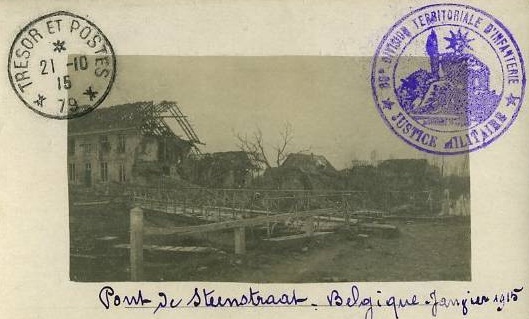
Left: Sketch the 151's positions in front of Steenstraet. Right: The Stenstraate Bridge in January 1915.
9 November: General Humbert commanding 32 CA orders that bayonet charges are to be launched in two columns against the German trenches at 0530 hrs. One column will advance to the east and the other two to the west of the Dixmude Road (i.e. Steenstraet - Bixchoote road). The first column makes it up to the first houses of Bixchoote (Bikschote) but is unable to pass beyond, while the other column is stopped by a ditch full of water. Boyaux (communication trenches) are dug in an attempt to approach the German lines. The men work throughout the night and the next day under constant German artillery fire, which takes certain trenches (those running perpendicular to the canal) by enfilade and making their occupation very dangerous. The situation is desperate. Orders arrive to hold on no matter the cost, and take additional terrain if possible and organize any conquered ground. The first objective then is to take additional ground in order to rectify the poorly positioned trenches.
10 November:A desperate fight erupts. Two companies (7 and 10 Cos.) to the east of the Dixmude Road are almost instantly annihilated in their trenches. When the regiment's machine-guns open up, the German troops are only 20 meters away. One gun jams but is immediately repaired and put back into action. But it's too late now. 1e Section is surrounded and captured by the Germans. The gunners of 2e Section destroy their guns rather than lose them to the enemy and as they attempt to flee are all shot down to the man. 3e Section continues fighting until all the gunners are killed in position. 10 November: In the night of 9-10 November, a heavy and uninterrupted German artillery barrage targets the regiment's trenches. Around 0400 hrs it intensifies for two hours, ending around 0600 hrs as a thick fog develops and greatly reducing visibility. As the artillery fire lifts, through the heavy mist and fog a German skirmish line appears only a few paces away from the regiment’s first line. Rifles blaze away as an even greater threat looms immediately behind this line as a large mass of German infantry appears advancing through approach trenches and behind the natural cover of the terrain (likely elements of the German 205 Reserve Infantry Reg.). A desperate fight erupts. Two companies (7 and 10 Cos.) to the east of the Dixmude Road are almost instantly annihilated in their trenches. When the regiment's machine-guns open up, the German troops are only 20 meters away. One gun jams but is immediately repaired and put back into action. But it's too late now. 1e Section is surrounded and captured by the Germans. The gunners of 2e Section destroy their guns rather than lose them to the enemy and as they attempt to flee are all shot down to the man. 3e Section continues fighting until all the gunners are killed in position.
The Germans pass over the regiment's first lines. 8 Co. manages to takes an entire German platoon prisoner, but as the group is being led off, the prisoner escort party (led by Adjudant-Chef Chiarelli) is taken by surprise by a greater enemy force. A desperate hand-to-hand fight ensues with fists, rifle butts and bayonets. Chiarelli, with saber and revolver in hand, repels the attackers and alone comes from this section but loses his prisoners.
 - on 10-10-1915.jpg?dl=0)
Adjudant-Chef Chiarelli (later promoted to sous-lieutenant) in 1915.
Sous-Lieut. Couplet commanding 8 Co. breaks his saber in the fight and is able to escape capture. During this time, the other officers of the regiment remain in the trenches and resist in place against overwhelming odds, following the order of the day to hold on no matter what the cost. One of the fallen is Captain Hameline who was lightly wounded at Nieuport at the end of October but returned to be acting commander of 2 Bat. after only a few days recuperation. During the course of the attack, Hameline is gravely wounded and as one of his men is attempting to carry him back, is shot again and killed. The liaisons of Capt. Dutour, commanding 3 Bat., are all killed. The companies of 3 Bat. manage to hold onto their positions, rotating in new units for their decimated ones, and under the covering fire of companies of 1 Bat., and make it back close to the canal. With the German attack now broken up, the regiment regroups on the left bank of the canal before being ordered to reorganize its positions, along with mixed elements from other units located near the Stenstraate bridge.
Sous-Lieut. Griés remains in position there commanding 1 and 2 Machine-Gun Sections, with Sergent Bavard in command of the 3 Section. Only 11 officers remained (of whom 6 are in 3 Bat.). 1 Bat. now consisted of a dismal 227 men, while 2 and 3 Bats. could only muster 846 men between them. Capt. Dutour goes to reassemble behind the canal [left bank] 3, 4, 5, and 6 Cos., along with elements of 1, 2, and 8 Cos. Dutour also comes upon elements of the 162 RI, and 80 and 90 [Tirailleurs] and organizes with these elements the defense of the left bank of the canal around noon.
At 1300 hrs, Commandant Bontin commanding the regiment receives the order to take command of all elements he finds around the Stenstraate bridge and to try to constitute a reserve. The units included are the remains of his own three battalions of the 151, the 80 and 90 [Tirailleurs] Battalions, two companies of 162 RI, and two companies of 60 BCP. At night, what remains of the 151 is sent to the rear.
Left: map showing approximate positions of the 151 RI on the morning of 10 November. The entire first line will be overrun in the morning, with almost half of the regiment being killed, wounded, or taken prisoner. Center: Ypres, 10 November 1914. Right: map showing areas of engagement on the evening of 10 November and approximate area of action for the 151 RI (42 DI).
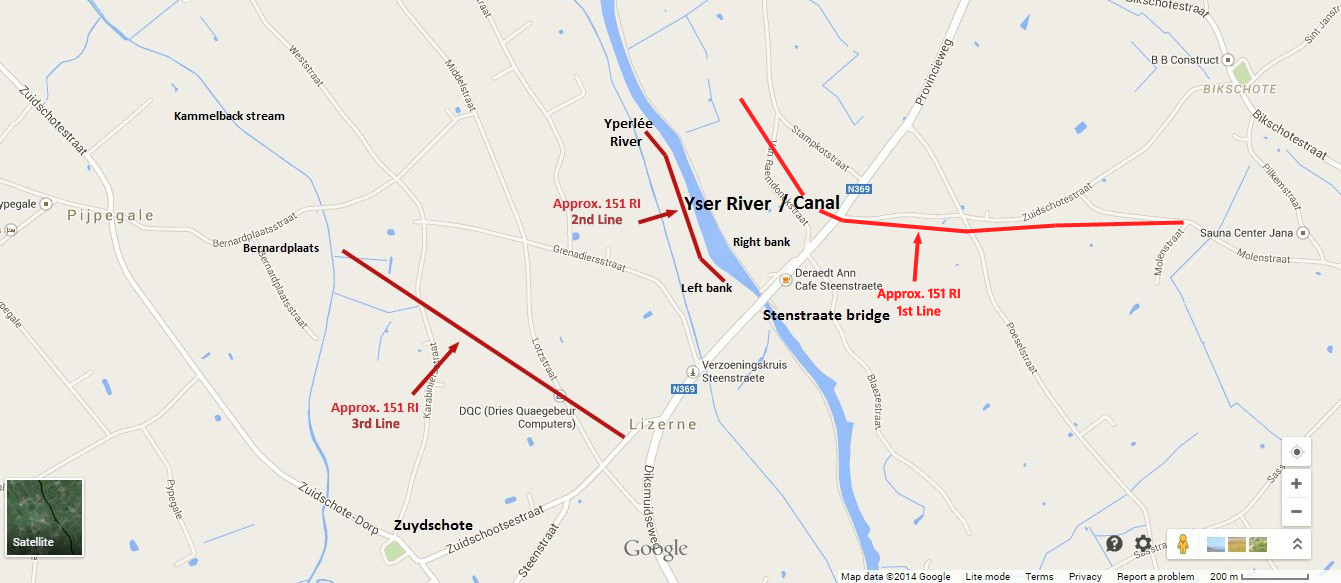
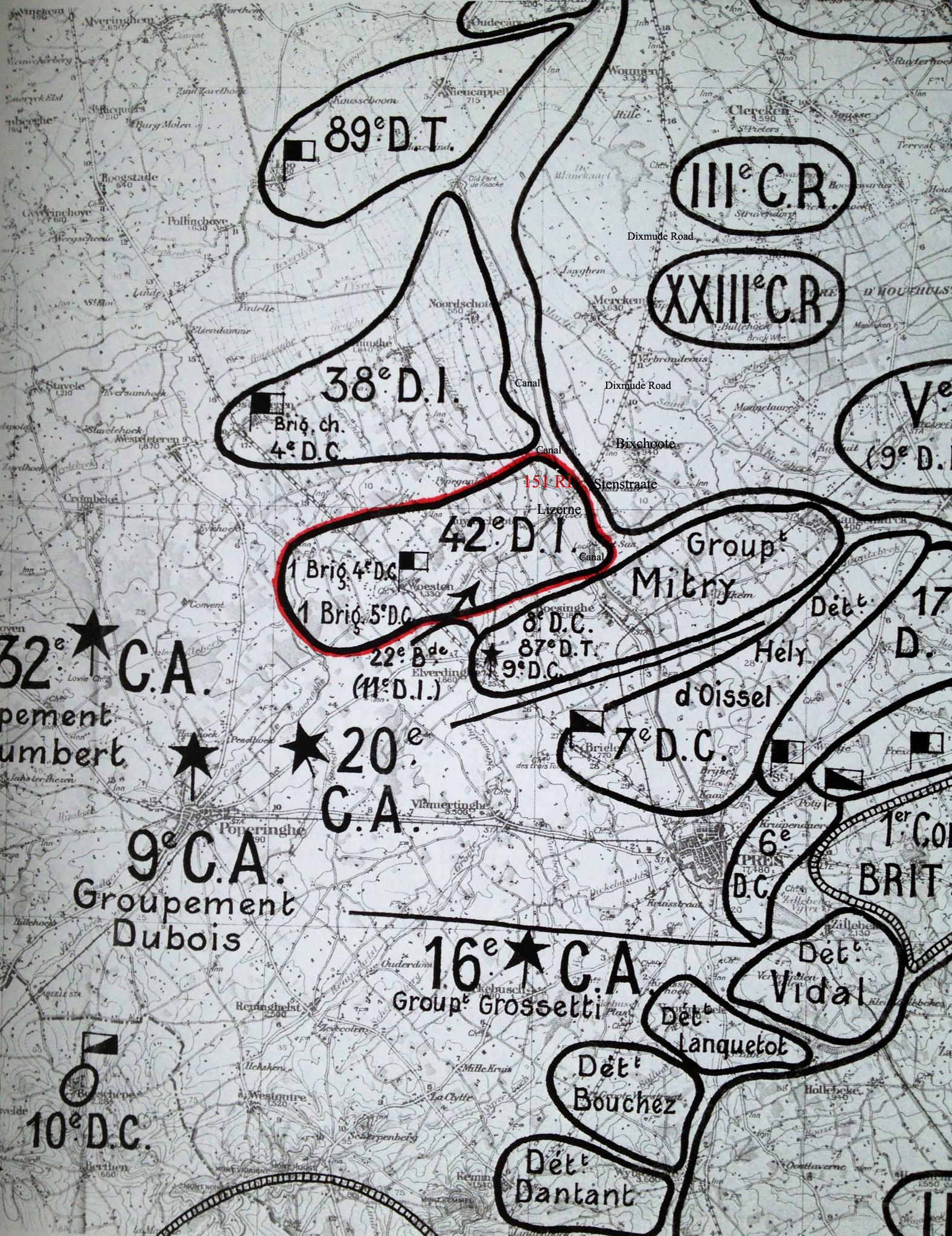
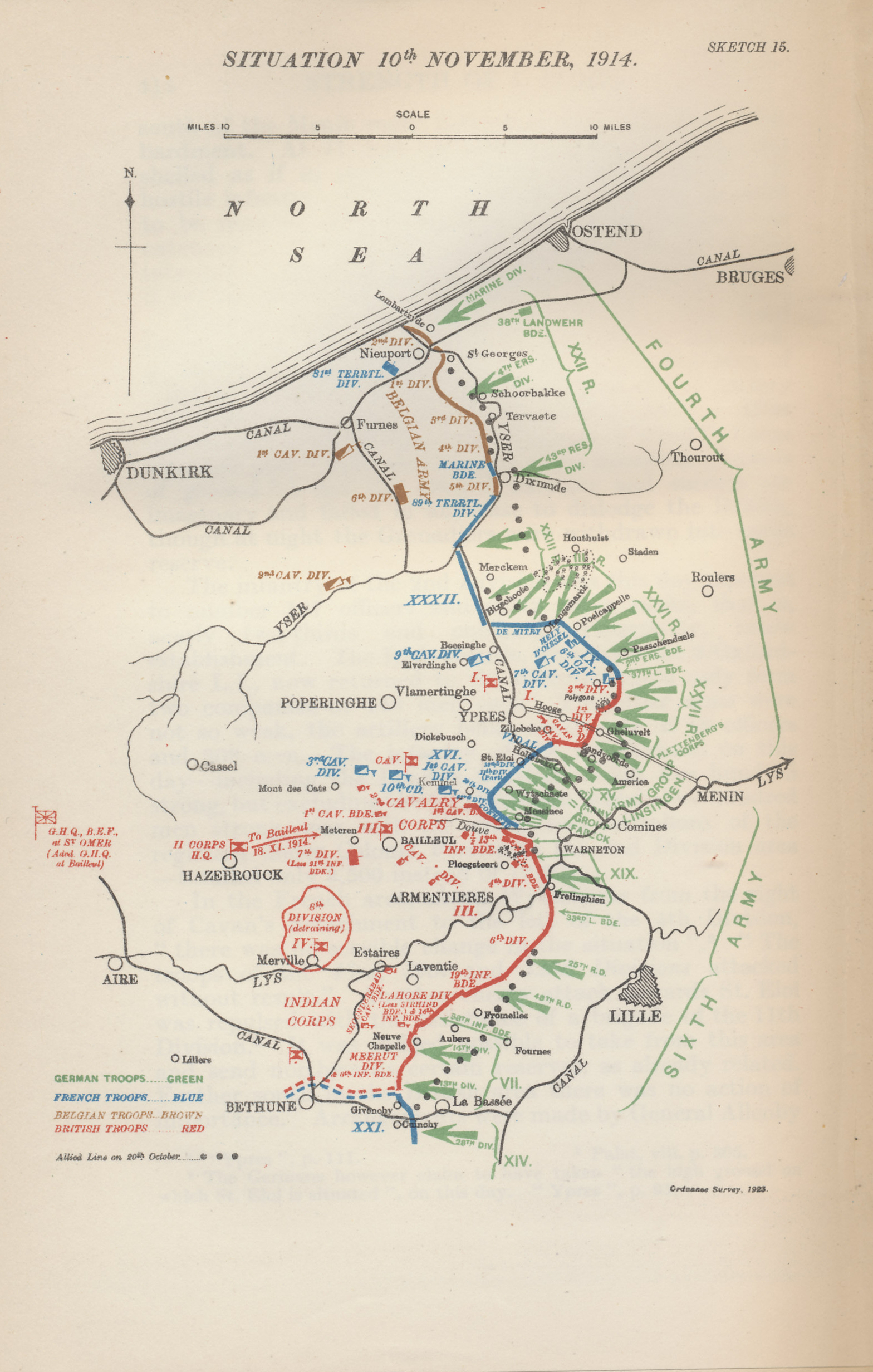
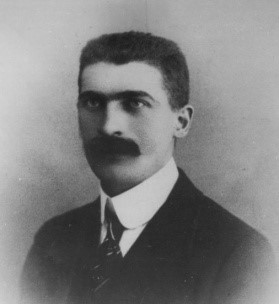
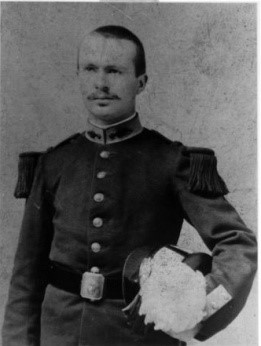
Capt. Louis Jean Lehoux and Capt. François Joseph Bazin.
